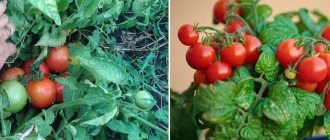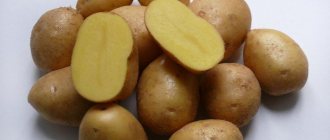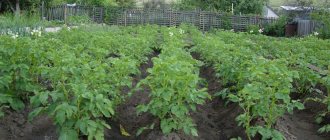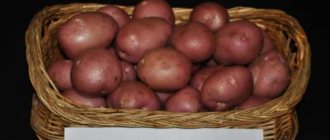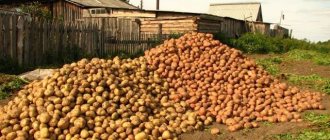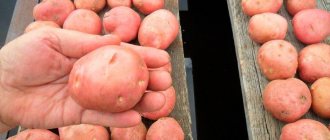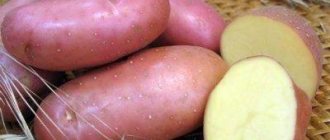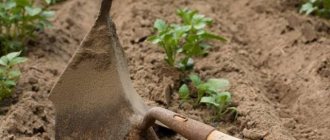Each region of Russia or other countries has its own potato varieties. Since it is impossible to plant those varieties of potatoes that were bred for the southern regions in cold areas, and vice versa. In this regard, residents of specific regions should familiarize themselves with the potato varieties that can be grown in their area and in their climatic conditions.
This article is devoted to the best potato varieties for the Moscow region: these are early (very early), mid-season, and late varieties. Also here are the names (along with descriptions) of the most delicious and productive potatoes.
Growing potatoes in the Moscow region
Favorable months for planting crops in this region are April, May, June, which depends on the plant variety. But you shouldn’t be in too much of a hurry to plant potatoes, since the crop does not tolerate cold well, except for special early varieties. Usually, starting from the second month of spring, the weather begins to stabilize: the temperature becomes relatively constant, the soil begins to warm up.
Features of planting and growing potatoes
Each potato variety requires certain planting conditions, but there are general recommendations that will help novice gardeners in handling this crop.
Not all potato varieties are suitable for the Moscow region
Note! The most important thing is to maintain the temperature regime. The soil must warm up so that the tubers do not freeze in the ground. To do this, about a month must pass from the day the cold weather subsides. Therefore, in the climatic conditions of the Moscow region, the recommended planting time is no earlier than mid-April.
The optimal soil temperature for planting potatoes is 7-8 °C, and the air temperature is from 8 °C for several weeks.
Tubers can be planted sprouted or without sprouts. Each case has its own characteristics. Stages of preparing potatoes with sprouts:
- Prepare seed at least 2-3 weeks before planting. Only healthy, whole tubers are selected.
- At room temperature, spread the material in boxes in 3-4 layers and place in the sun.
- Spray with water from a spray bottle for two weeks, then put in a cool, dark place.
Properly prepared tubers for planting
Important! It is not recommended to keep the material in a warm place for too long, as the sprouts will become too long. Potatoes with shoots larger than 10 cm are not suitable for planting.
When planting potatoes without prior germination, no special preparation is required. However, the weather conditions during planting should be the most favorable, since the tuber will not sprout in cold soil, and the germination time will be slightly longer than with prepared material.
Planting potatoes in the ground is done in different ways, but in the Moscow region, summer residents mainly prefer growing in trenches, which is due to the characteristics of the soil. Description of the stages of such a landing:
- Loosen the soil over the entire crop area.
- Level the ground by making straight trenches, leaving about 70 cm between them.
- Add fertilizer and sprinkle with a little soil.
- Lay out the potatoes in rows with intervals of 30 to 40 cm to a depth of 5-10 cm.
- Cover the tubers with soil and compact them.
Example of laying out tubers
After planting until harvest, plants require care, which consists of watering, fertilizing, hilling and treatment against diseases and pests.
The bushes should be watered from the third week after germination as the soil dries. It is important not to overdo it with water so that the roots do not rot.
Potatoes need to be fed no more than twice during cultivation: after emergence and during flowering.
It is also necessary to loosen the soil and hill up the bushes after the emergence of seedlings. The procedures must be carried out carefully so as not to damage the sprouts that have not yet become strong.
There are two ways to protect the future harvest from pests: biological and chemical. The first involves planting plants that repel insects, or spraying with infusions and biological products, the second involves treating with chemical compounds. The latter method helps protect the bushes not only from pests, but also from diseases.
Important! Chemical treatment of potatoes should be carried out only before root crops are set. This type of protection is the most effective, but if done incorrectly, it can cause harm to plants and humans.
Secrets of planting for the winter
Many residents of the Moscow region are increasingly planting potatoes in early autumn. It has already been established that the winter harvest is strong and abundant, but tubers are not always able to survive the periods of little snow characteristic of milder winters. So, you need to take a more careful approach to choosing a planting method.
For the winter, the crop should be planted using one of two methods - in trenches or “under a shovel”. In the case of ridge technology, the tubers will be subject to seasonal changes: under the influence of the wind, the hills will collapse, and the raw materials will instantly freeze due to low temperatures. After planting potatoes, it is important to thoroughly mulch the soil, since a maximum insulating layer is a guarantee of safe wintering.
The most delicious potato varieties for the Moscow region
The best-tasting potato varieties for the Moscow region are recommended for preparing a variety of dishes; such potatoes practically do not boil over and do not darken during processing. It mainly ripens towards the end of summer.
Tuleevsky
Refers to mid-season varieties that bring a bountiful harvest. It is recommended to fertilize tubers when planting with natural substances, for example, humus. It does not deteriorate during transportation, does not suffer from cancer, and is moderately susceptible to parasites and diseases. The ripening period is about 90-110 days.
Share
It should be planted with short shoots in mid-spring, when frost is no longer expected. Tubers ripen in 75-90 days. An unpretentious variety that grows well in different conditions.
Picasso
Tolerates changeable weather well and does not suffer from drought. Despite its ease of care, it is poorly stored and requires serious processing before sowing. A very tasty potato variety with thin skin. Ripens in 120-140 days.
Aspia
Resistant to weather changes and high temperatures, does not require too frequent watering. Productivity is average. Highly susceptible to late blight and viruses. It has a characteristic taste, slightly fruity. Ripening time is about 100-110 days.
The Aspia variety has a slightly fruity taste
Planting tubers without sprouts
According to classical technologies, before planting in open ground, tubers need to be kept in a warm room for germination of sprouts, which will ensure better fruitfulness of root crops. However, experienced gardeners believe that with favorable soil and stable climatic conditions, it is possible to do without preliminary germination. So, the sprouts will appear directly in the soil, and then the leaves will emerge and the harvest will appear.
Planting potatoes without sprouts is done in the following order:
- Sort through the tubers, removing low-quality seed. Let us remind you that it is not necessary to keep potatoes for 1-2 weeks in a warm room, since planting is done without sprouts.
- Plant potatoes using any chosen technology. Since there are no sprouts, the tubers can be thrown into the holes on either side.
Planted potatoes require proper fertilization and hilling. It is equally important to ensure regular watering.
It is important to consider that with this technology it takes more time for the fruit to ripen. If the planting dates were violated, the sprouts will not germinate and the desired harvest will not be obtained.
Super early and early potato varieties
Since summers in this region are often rainy, early potato varieties for the Moscow region are a common solution for many gardeners.
Note! Early varieties are least susceptible to diseases and parasites, even if they have low resistance to them. The reason is that the plant has time to ripen before the infection begins to actively develop in the soil.
Zhukovsky early
Ultra-early potatoes ripen in 70-80 days. Insensitive to weather changes, stores well. Best suited for frying, making chips or French fries.
Priekulsky early
Early ripening variety. Brings a large harvest, but is susceptible to diseases and viruses. It can be stored for a long time under standard conditions.
Early Rose
Another name is American. It is juicy and suitable for making potato juice. The variety is not resistant to viruses and potato cancer. Does not tolerate long-term storage.
Falensky
A universal potato variety that is resistant to cancer. It stores well and has high taste.
Variety Falensky is resistant to potato blight
The best of mid-early and mid-ripening varieties for the Moscow region
The main properties of medium potato varieties are high immunity to various diseases.
Detskoselsky
It is resistant to diseases, viruses, and cancer. Unpretentious in the choice of mail. Recepts fertilizers favorably.
Favorite
Does not respond to temperature changes. Resistant to viral diseases. It can be stored for a long time if the conditions are met. The variety has high yield.
Sineglazka
A very tasty potato variety, yielding up to 500 kg per hundred square meters of land. Easily adapts to growing conditions and is immune to many diseases. It doesn't store well in large quantities.
Nevsky
A high-yielding variety with high immunity and the possibility of long storage. Tolerates mechanical damage and transportation.
The Nevsky variety can be transported over long distances, and it will not deteriorate
Characteristics of late early varieties
Experienced gardeners do not recommend late varieties of potatoes for the Moscow region due to the climatic characteristics of the region: cool summers and rainy autumns. However, there is a popular variety suitable for such conditions. This is Lorch, immune to weather changes, viruses and diseases. It has good taste and almost does not darken during processing. Does not require special care, unpretentious.
The Lorch variety does not require special care
Growing a good potato harvest in the Moscow region will not be difficult if planting and caring for the plant are carried out taking into account the characteristics of the selected variety. Advice for beginning gardeners: plant several types of crops for the first time to compare their survival rates and find out which variety is suitable for a given site.
Choosing a landing site
Potatoes produce a good harvest on sandy and loamy soils. It is important to take into account what crops previously grew in the garden, since failure to follow crop rotation rules leads to tubers being affected by various diseases. Thus, it is unacceptable to grow potatoes in a garden bed where the following crops previously grew:
- nightshades (tomato, potato, eggplant, pepper, etc.);
- sorghum;
- sunflower.
Favorable predecessors are the following plants:
- cucumber;
- legumes;
- cabbage;
- pumpkin.
As for a safe neighborhood, you can plant next to potatoes:
- carrot;
- beets;
- calendula;
- legumes
The listed crops are not only harmless to root crops, but also useful because they saturate the soil with useful microelements.
The area where you plan to plant potatoes should be in a sunny and open place, away from shadows from trees. However, you should not plant tubers in lowlands, as they can rot during growth due to high soil moisture.
